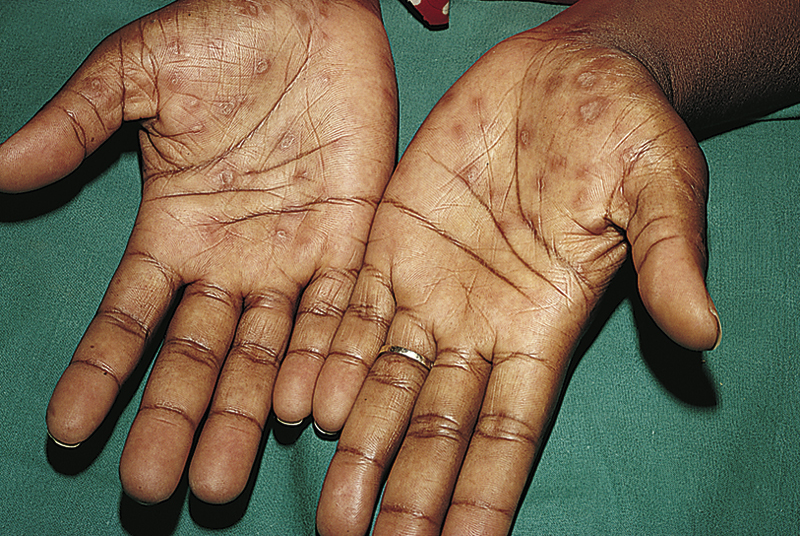syphilis /sif″ilis/ [from the name of a literary figure (1530) who was thus infected (literally, L, lover of swine)] , a sexually transmitted disease caused by the spirochete Treponema pallidum, characterized by distinct stages of effects over a period of years. Any organ system may become involved. The spirochete is able to pass through the human placenta, producing congenital syphilis. Also called lues. See also chancre, gumma, Hutchinson’s teeth, Hutchinson’s triad, snuffles. −syphilitic, adj. ▪ OBSERVATIONS: The first stage (primary syphilis) is marked by the appearance of a small, painless red pustule on the skin or mucous membrane between 10 and 90 days after exposure. The lesion may appear anywhere on the body where contact with a lesion on an infected person has occurred, but it is seen most often in the anogenital region. It quickly erodes, forming a painless, bloodless ulcer, called a chancre, exuding a fluid that swarms with spirochetes. The chancre may not be noticed by the patient, and many people may become infected. It heals spontaneously within 10 to 40 days, often creating the mistaken impression that it was not a serious symptom. The second stage (secondary syphilis) occurs about 2 months later, after the spirochetes have increased in number and spread throughout the body. This stage is characterized by general malaise; anorexia; nausea; fever; headache; alopecia; bone and joint pain; and the appearance of a morbilliform rash that does not itch, flat white sores in the mouth and throat, or condylomata lata papules on the moist areas of the skin. The disease remains highly contagious at this stage and can be spread by kissing. The symptoms usually continue from 3 weeks to 3 months but may recur over a period of 2 years. The third stage (tertiary syphilis) may not develop for 3 to 15 or more years. It is characterized by the appearance of soft, rubbery tumors, called gummas, that ulcerate and heal by scarring. Gummas may develop anywhere on the surface of the body and in the eye, liver, lungs, stomach, or reproductive organs. Tertiary syphilis may be painless, unnoticed except for gummas, or it may be accompanied by deep, burrowing pain. The ulceration of the gummas may result in punched-out areas of the palate, nasal septum, or larynx. Various tissues and structures of the body, including the central nervous system, myocardium, and valves of the heart, may be damaged or destroyed, leading to mental or physical disability and premature death. Congenital syphilis resulting from prenatal infection may result in the birth of a deformed or blind infant or stillborn child. In some cases, the infant appears to be well until, at several weeks of age, snuffles, sometimes with a blood-stained or mucopurulent discharge, and skin lesions, particularly on the palms and soles or in the genital region, are observed. Such children also may have visual or hearing defects, and progeria and poor health may develop. Diagnosis of syphilis is made by dark field microscopy of fluid from primary or secondary stage lesions, by bacteriological study of blood samples, and by an examination of cerebrospinal fluid. Because of the slow development of the disease during the early stages, the various serological tests, including the obsolete Wassermann, may not produce accurate findings until months after exposure. Repeated tests and cross-checking with more than one test may be required in some cases. The report by a person that exposure to syphilis has occurred is often the only evidence available to the clinician. ▪ INTERVENTIONS: Patients with primary or secondary syphilis are usually given benzathine, penicillin G benzathine, or an equivalent in a single dose of 2.4 million units intramuscularly. The objective is to maintain penicillin in the bloodstream for a number of days because Treponema pallidum divides at an average rate of once every 33 hours, and the antibiotic is most effective during the stage of cell division. Larger doses of penicillin, 7.2 million units total, are administered in 3 doses 1 week apart for tertiary syphilis. Infants and small children with congenital syphilis are usually given 50,000 units/kg intramuscularly. Treatment of an infected mother with penicillin during the first 4 months of pregnancy usually prevents the development of congenital syphilis in the fetus. Treating the mother with antibiotics later in the pregnancy usually eliminates the infection but may not protect the fetus. Patients should be reexamined clinically and serologically 3 months and 6 months after treatment. Human immunodeficiency virus-infected patients (also infected with syphilis) should be seen at 1, 2, 3, 6, 9, and 12 months for follow-up observation. ▪ PATIENT CARE CONSIDERATIONS: Special care and aseptic precautions are taken while handling the highly contagious fluid from syphilitic lesions used in diagnostic testing because the infection may be acquired through a cut or break in the skin. The nurse discusses with the patient the disease course, its treatment, and ways of preventing future infections. The extremely contagious nature of the infection is explained, and the importance of treatment for all who may have been exposed is emphasized. Tact, patience, and understanding are required to reassure the patient and to secure the patient’s cooperation in accepting treatment and in assisting in the identification and location of others needing treatment. Active, serologically documented cases of syphilis must, by law, be reported to local departments of health throughout the United States.


